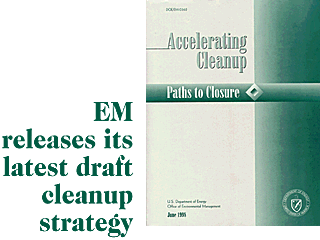

 |
Accelerating Cleanup: Paths to Closure (ACPC) is the latest version of the Office of Environmental Management's plan to clean up and shut down its former nuclear weapons complex. Released on June 30 for public comment, ACPC is EM's most recent site-by-site projection of the cost, schedule, and scope of its massive cleanup effort. |
| In fiscal year 1996, EM began to rethink the notion
that cleanup would take in excess of 30 years to
accomplish. The Ten-Year Plan launched DOE sites on a
planning process for telescoping the cleanup so major
cleanup activities would be complete in ten years. The
original Ten-Year Plan concept with its sense of urgency
about cleaning up and closing out the complex has been
incorporated into ACPC. Through yearly updates to the
site deployment plans contained in ACPC, EM is building a
blueprint for cleanup that reflects what can be
realistically accomplished by 2006. EM's goal is cleaning
up more than 90 percent of DOE sites by 2006 and reducing
the cost of cleanup at remaining sites. ACPC contains cost, schedule, and scope information on 353 projects across 53 DOE waste sites. The document also contains an actual or, more often, a planning-based cleanup "end state" for each site. Current life-cycle estimates for this cleanup total $147 billion in constant FY98 dollars for all 353 projects through 2070. For the first time since planning for accelerating site closure began, every site has a critical closure path, identifying the key technical and programmatic activities that must occur before closing a site. The current ACPC also contains for the first time potential roadblocks on the critical closure paths, including technological uncertainties. Also, FY98 is the first time that each site has waste and materials disposition maps that describe each waste stream, the steps for processing or managing the wastes, and disposition plans for the wastes. OST's role is to invest in strategic science and technology development and deployment activities to mitigate technological risks associated with sites' plans for handling their waste problems. To read ACPC online, see http://www.em.doe.gov/ closure/final/onlinenp.html. |